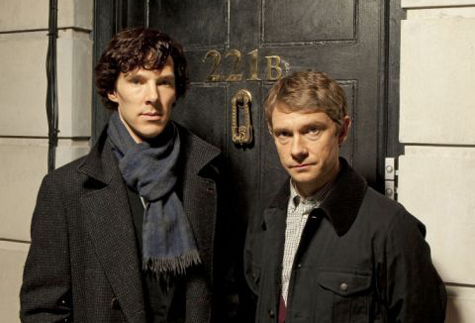
I have to admit up front that, for me, The Blind Banker was a bit of a let down. Even though I wasn’t that taken with the crime or criminal in A Study In Pink, the story worked well in bringing together the most important characters of the series and moving them along with the plot so the presentation of character details felt less like exposition and more like good fun. And the killer’s process was relevant in that he was capable of enticing Sherlock into a vulnerable position. Here again I am not compelled by the problem of who is leaving the ciphers or what they portend and the problem with that is there isn’t much else going on. Sherlock and Watson are dealing with some wet behind the ears, totally average Scotland Yarder rather than Lestrade and besides missing that nuanced character, I would much rather look at Rupert Graves’ face, thank you very much. We get mere glimpses of Mrs. Hudson and Molly, two important characters we haven’t seen enough of up to now, and at the end there’s just a whisper of Moriarty, who we simply cannot wait to encounter.
So aside from the story of the crime, which is wholly invented and only makes minor allusions to Conan Doyle’s works, what we have here is the evolution of the Sherlock/Watson relationship. And hey, that’s swell. It’s even quite funny in its moments, but as a whole the episode doesn’t hold a candle to anything else in the series. I’m not saying skip it…because some of those getting to know you moments are quite telling.
For instance, Sherlock and Watson visit the offices of a businessman who used to be a schoolmate of Sherlock’s and the interaction between Sherlock and this Sebastian person tells us—and Watson—a lot.  Not surprisingly, Sherlock seems to have always been the way he is and his recitation of observations did not serve him well, at least not socially, in school. What is surprising is that Sherlock refrains from doing it in front of Sebastian, even going so far as to lie to get out of it. And he takes the case while pointedly refusing any incentives, namely a fat check. Clearly Sherlock loathes everything Sebastian stands for and yet still feels the need to prove his own worth to someone who must have been a rival of sorts. (Watson, poor pragmatist that he is, snaps up the check.) And there is the fact that Sebastian called upon Sherlock to solve this problem without knowing of his status as a consulting detective, since Watson’s blog hasn’t yet reached a sensational level of readers. All very telling indeed.
Not surprisingly, Sherlock seems to have always been the way he is and his recitation of observations did not serve him well, at least not socially, in school. What is surprising is that Sherlock refrains from doing it in front of Sebastian, even going so far as to lie to get out of it. And he takes the case while pointedly refusing any incentives, namely a fat check. Clearly Sherlock loathes everything Sebastian stands for and yet still feels the need to prove his own worth to someone who must have been a rival of sorts. (Watson, poor pragmatist that he is, snaps up the check.) And there is the fact that Sebastian called upon Sherlock to solve this problem without knowing of his status as a consulting detective, since Watson’s blog hasn’t yet reached a sensational level of readers. All very telling indeed.
Then there’s the matter of Sarah.
“I need to get some air—we’re going out tonight,” says Sherlock.
 “Actually, I’ve got a date,” says Watson.
“Actually, I’ve got a date,” says Watson.
“What?”
“It’s where two people who like each other go out and have fun?”
“That’s what I was suggesting,” says Sherlock.
“…No, it wasn’t. At least I hope not.”
He wants to take her to dinner and a movie, but Sherlock has other plans and sets them up with tickets to a Chinese circus performance where he hopes to locate a suspect. Then he gets himself a ticket, turns up, and completely hijacks the date. Just about everything goes wrong, but Watson never stops trying to salvage the evening. Even after they’ve been taken hostage and nearly killed he says, “Don’t worry, the next date won’t be like this.”
And so we observe one of the fundamental differences between our main characters, how they regard women. Earlier in the episode Sherlock needed something from Molly Hooper, the lovely girl in the coroner’s office who so clearly has a crush on him, and when she hedged he complimented her hair. We think he’s oblivious to emotions, but like so many other details he seems to ignore them until they become relevant or useful to him. It’s the same reason he leaves Watson outside ringing the bell once he’s broken into yet another flat—he doesn’t need him just then. You might then conclude that Sherlock treats women the same as everyone else, but you’d be missing the point. He treats everyone terribly, but he makes an effort at being slightly more human for John Watson.

